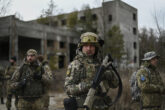April 13, 2017
How Trump Can Build a 350-Ship Navy
When President Donald Trump wanted to send a message to North Korea, he did it the old-fashioned way: by sending the USS Carl Vinson—a Nimitz-class aircraft carrier that holds a crew of 5,200 people and bristles with some 65 or so fixed-wing aircraft and helicopters—steaming toward the Korean Peninsula.
An aircraft carrier is the ultimate expression of American power, a floating military base whose arrival inspires fear in our enemies and heartens our allies. The Vinson, along with its strike group of two destroyers and one cruiser, certainly caused top officials in Beijing and Pyongyang to sit up and notice. North Korea called the deployment “outrageous,” while China expressed “concern.” If both countries’ leaders didn’t understand how serious Trump is about stopping North Korea’s race toward nuclear-tipped missiles, they get it now.
This is exactly why America has a Navy—and exactly why it’s so important that we rebuild it after years of atrophy as a result of the war on terrorism and budget constraints under President Barack Obama. Unfortunately, the Navy is no longer large enough to remain persistently forward-deployed to uphold international law or fully protect the nation’s interests. Set aside security threats like North Korea—the entire international economic system, nearly wholly dependent upon huge container ships, is nearing its fracture point. Once broken, this system based upon a loose maritime law consensus that is enforced by American naval might, will be difficult to reestablish.
Read the full article at Politico.
More from CNAS
-
Defense / Transatlantic Security
When Defense Becomes Destruction: Austria-Hungary’s Mistake and Ukraine’s RiskThis article was originally posted on War on the Rocks. The southeastern Polish city of Przemyśl, with its elegant 19th century Habsburg-era train station, remains one of the ...
By Franz-Stefan Gady
-
Defense / Transatlantic Security
Ukraine’s Catch-22 MomentThis article was originally published in the Financial Times. In Joseph Heller’s wartime classic, Catch-22, the protagonist Yossarian seeks out the US army surgeon Doc Daneeka...
By Franz-Stefan Gady
-
CNAS Insights | Budgetary Own Goals Undermine “Speed and Volume”
On November 7, Secretary of Defense Pete Hegseth laid out a plan to overhaul the Department of Defense’s (DOD’s) acquisition system. Placing an emphasis on delivering new capa...
By Philip Sheers, Carlton Haelig & Stacie Pettyjohn
-
Drones: Who Is Making the New Weapons of War?
From Ukraine and Russia to Gaza and Sudan, drones have become a key weapon of war. Which companies are making them, and profiting from this rapidly expanding but controversial...
By Stacie Pettyjohn




